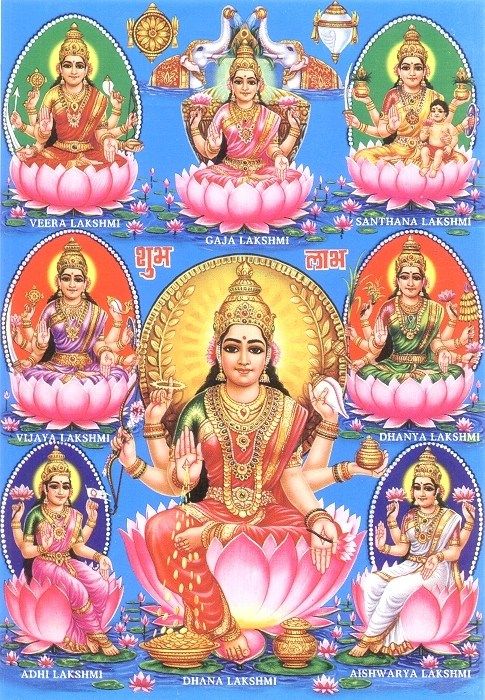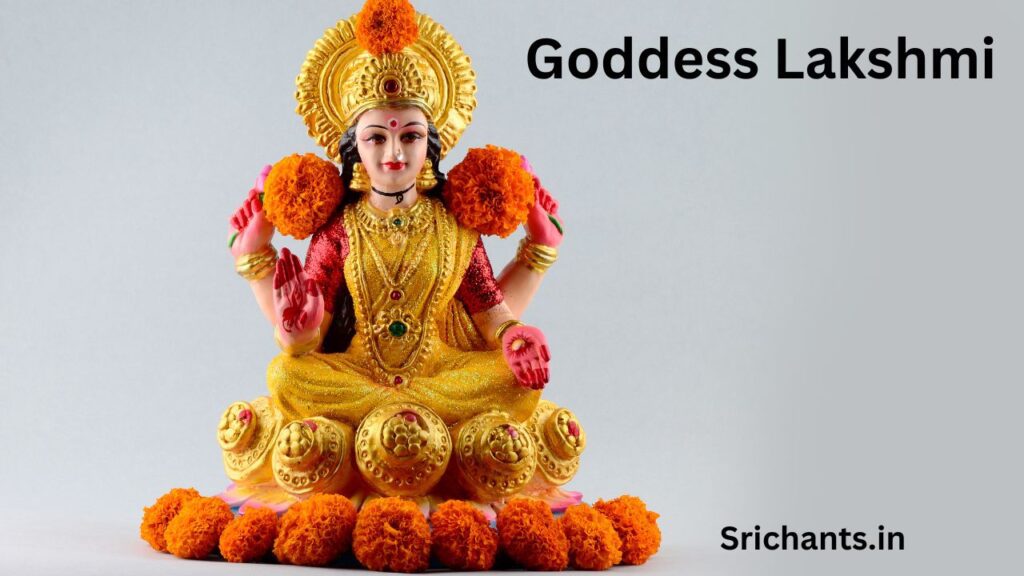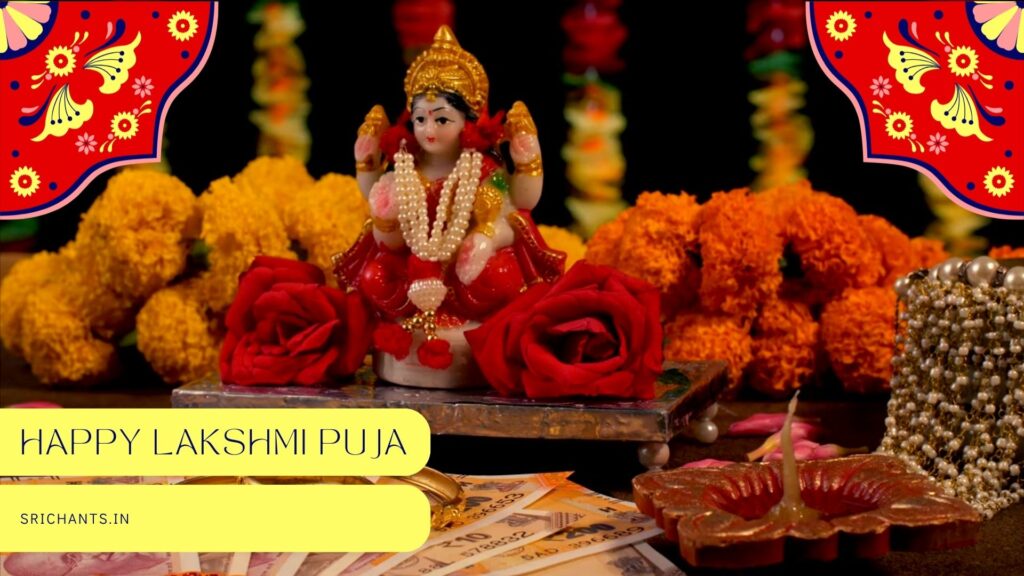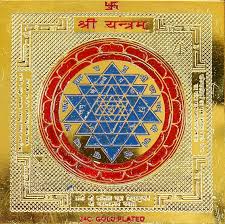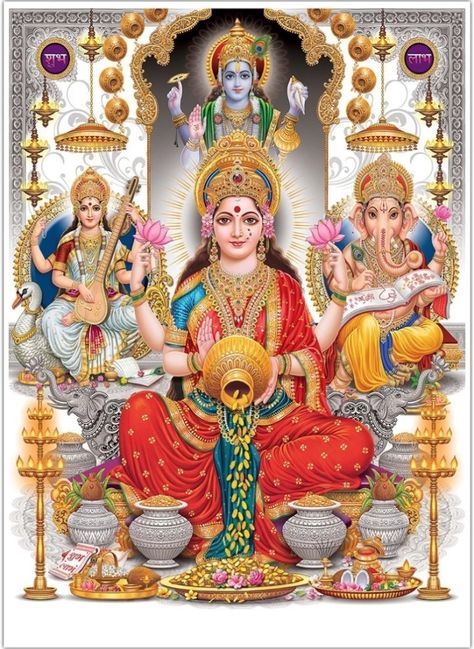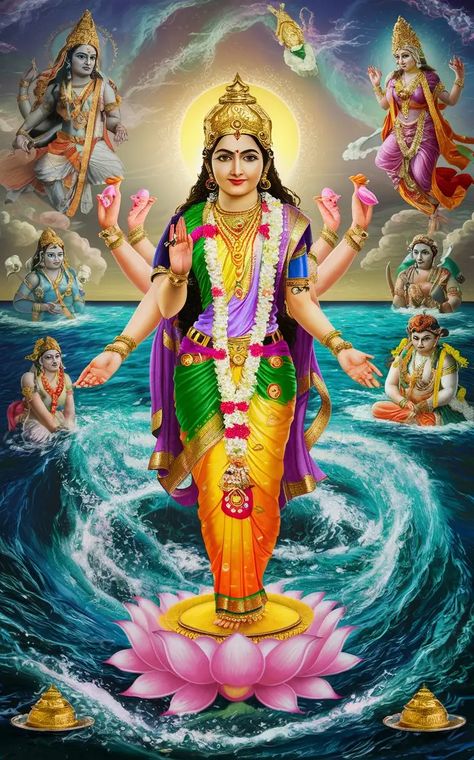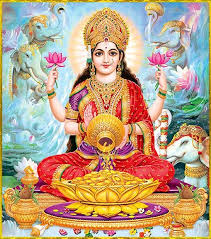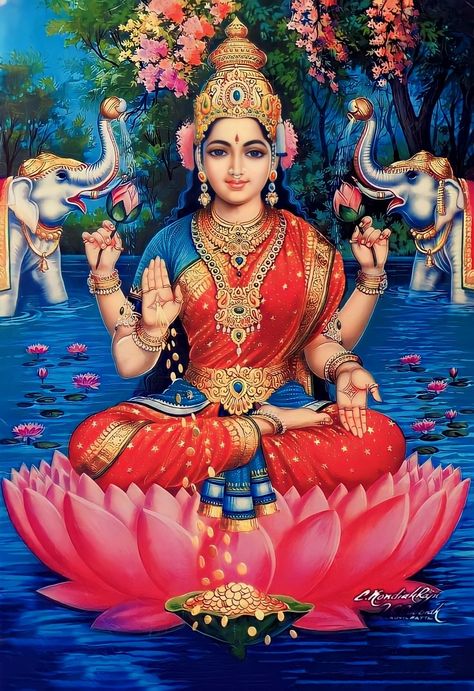Lakshmi Ashta : Eight Manifestations of the Goddess
Introduction
The divine embodiment of affluence, prosperity, and abundance, Goddess Lakshmi, is held in high regard by Hindus worldwide. Lakshmi, the consort of Lord Vishnu, the preserver of the universe, is regarded as a multifaceted deity who bestows a variety of favors upon her devotees. The symbolism and iconography that surround this revered deity provide a captivating glimpse into the rich tapestry of Hindu mythology, ranging from material affluence to spiritual enlightenment.
The Meaning and Significance of Lakshmi
The name “Lakshmi” is derived from the Sanskrit word “Laksya,” which means “aim” or “goal.” This name emphasizes her status as the goddess who assists individuals in achieving prosperity, both material and spiritual. Lakshmi is the embodiment of the qualities of good fortune, purity, generosity, and the essence of beauty, grace, and appeal. Devotees have sought her blessings to acquire or preserve wealth and prosperity, and her worship has been a fundamental aspect of the Indian tradition since primordial times.
One of the fundamental beliefs associated with Lakshmi is that she only inhabits households that are both clean and industrious, and she avoids locations where the inhabitants are unclean or unmotivated. This concept emphasizes the significance of hygiene and diligence in both personal and professional life, as Lakshmi’s presence is believed to bring prosperity and success. Lakshmi’s four hands, which represent her capacity to bestow the four Purusharthas (ends of human life): Dharma (righteousness), Artha (wealth), Kama (pleasures), and Moksha (liberation), are the active energy of Lord Vishnu.

The Enchanting Iconography of Goddess Lakshmi
Lakshmi is frequently depicted as a stunningly attractive goddess, either sitting or standing, on an eight-petalled lotus flower that emerges from a lake in the rich tapestry of her iconography. Lakshmi’s appearance is a testament to her association with the sacred flower, as she is adorned with a lotus garland and holds lotuses in each of her two hands.
Pureness, enlightenment, and the divine’s capacity to transcend the material world are all symbolized by the lotus, which has the capacity to bloom in muddy waters and ascend above the surface. Lakshmi’s association with this auspicious flower symbolizes her ability to bestow spiritual and material bounty upon her devotees, thereby guiding them toward enlightenment and prosperity.
Variations in Lakshmi’s Complexion and Attributes
Lakshmi’s complexion is depicted in a variety of tints, each of which carries a unique symbolic significance. A golden-yellow complexion is used to represent her as the source of all wealth, while a dark complexion is used to denote her as the consort of the dark-hued Lord Vishnu. Her compassionate nature as the mother of all creation is reflected in her more prevalent pinkish complexion. Conversely, the universe has evolved from the ultimate form of Prakriti (nature), which is symbolized by a white complexion.
Lakshmi is frequently depicted bearing other symbolic objects in her hands, in addition to the lotus. These include a conch shell, which symbolizes auspiciousness and the divine sound of creation; a pot of nectar or ambrosia, which represents the elixir of immortality; a citron fruit, which signifies her transcendence over the created worlds; and a bilva fruit, which represents the highest spiritual elevation of Moksha.
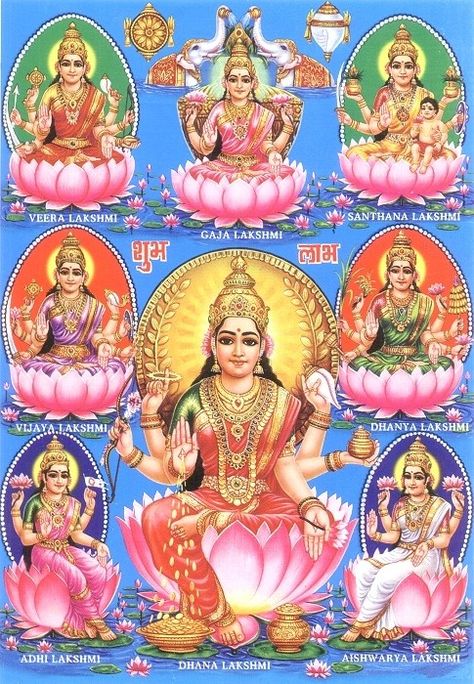
The Ashta Lakshmi: Eight Manifestations of the Goddess
The “Eight Forms of Lakshmi,” or Ashta Lakshmi, are of particular importance within the extensive iconography of Lakshmi. These distinctive manifestations of the deity are indicative of the diverse blessings she bestows upon her devotees, which encompass a variety of life experiences and spiritual development.
Adi Lakshmi: The Primordial Form
Adi Lakshmi, also referred to as Moksha Pradayani, is the primordial manifestation of the goddess, representing the ultimate objective of life: liberation from the cycle of birth and death. Adi Lakshmi’s iconography is depicted with four hands, and it includes the Abhaya mudra (gesture of fearlessness) and the Varada mudra (gesture of bestowing boons), which symbolize her compassionate guidance toward the attainment of Moksha.
Dhana Lakshmi: The Bestower of Wealth
The second form of Ashta Lakshmi, Dhana Lakshmi, is the embodiment of material, physical, and intellectual affluence. The six hands of Dhana Lakshmi are adorned with exquisite jewelry and are situated on a pink lotus. She is holding a discus, a conch, a bow and arrow, a water pitcher, a lotus, and her palm in the Abhaya mudra, with gold coins flowing from it.
Dhanya Lakshmi: The Goddess of Agriculture and Sustenance
Dhanya Lakshmi, the third form, symbolizes the abundance of food and the bounties associated with agriculture. Dhanya Lakshmi is depicted in a lush green attire, symbolizing growth and renewal. She is situated on a pink lotus and holds a variety of agricultural products in her eight hands, underscoring the significance of gratitude for the miracles of Mother Nature.
Gaja Lakshmi: The Bestower of Animal Wealth
The fourth form, Maa Gaja Lakshmi, is highly regarded as the provider of animal prosperity, a sentiment that is especially cherished by farmers who depend on cattle, bulls, and other livestock for their livelihood. Gaja Lakshmi’s iconography emphasizes her role in supplying the resources required for agricultural endeavors, as she is flanked by two white elephants that are sprinkling her with water.
Santana Lakshmi: The Goddess of Fertility and Progeny
The fifth form, Santana Lakshmi, is the embodiment of fertility and the blessing of offspring. Santana Lakshmi’s iconography, which depicts her cradling an infant in one of her six hands and is adorned with vibrant flowers, underscores the sacred responsibility of parenthood by fulfilling the desire for healthy and joyous offspring.
Veera Lakshmi or Dhairya Lakshmi: The Bestower of Courage and Valor
Veera Lakshmi, also referred to as Dhairya Lakshmi, is the sixth form of the deity of bravery and determination. Veera Lakshmi, who is depicted with eight hands holding a variety of weapons and symbols, embodies the courage necessary to confront life’s obstacles and maintain a resolute stance in the presence of adversity.
Vidya Lakshmi: The Goddess of Knowledge and Intellect
The seventh form, Vidya Lakshmi, is the patron of intellectual development and knowledge. Vidya Lakshmi’s blessings are sought by those who aspire to spiritual transformation and the unlocking of their complete potential, as she is depicted holding lotuses in her four hands and positioned in the Abhaya and Varada mudras.
Vijaya Lakshmi: The Embodiment of Victory and Success
The eighth form, Vijaya Lakshmi, is the embodiment of achievement and triumph. Vijaya Lakshmi’s iconography, which is adorned in a vibrant crimson and features a discus, sword, shield, and other symbols of power, motivates her followers to surmount challenges and achieve success in all of their pursuits.
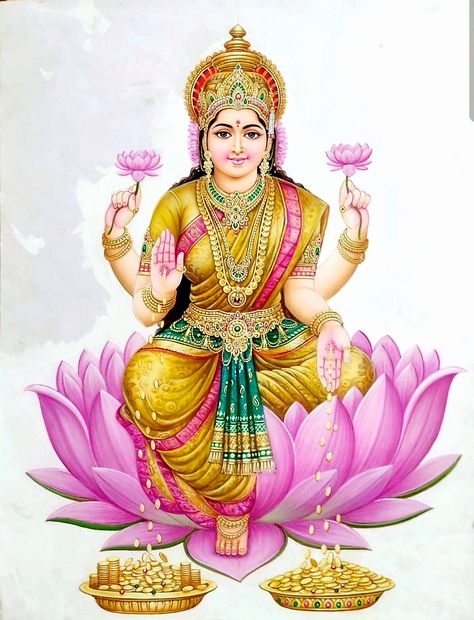
The Significance of Lakshmi’s Vahana: The Owl
The owl is depicted as the carrier-vehicle, or Vahana, of Goddess Lakshmi in certain sculptural representations. This association is of profound symbolic significance, as the owl, despite its despised status in contemporary society, was held in high regard in ancient religious texts.
The owl, as Lakshmi’s Vahana, is symbolic of intelligence, penetrating insight, and royalty. This connection emphasizes the goddess’s capacity to provide her devotees with the wisdom and discernment necessary to navigate the intricacies of life and achieve success.
Lakshmi’s Festivals and Rituals
Despite the fact that Goddess Lakshmi is revered on a daily basis, the month of October is particularly significant to her followers. In her honor, the festivals of Sharad Purnima (Kojagiri Purnima) and Diwali are observed, symbolizing the triumph of light over darkness, knowledge over ignorance, and hope over despair.
Gaja Lakshmi Puja, which is observed on Sharad Purnima, is a harvest festival during which devotees offer their appreciation for the abundance of the season and request Lakshmi’s blessings for ongoing prosperity. Kojaagari Purnima, also known as Kumar Purnima or Sharad Purnima, is a period of celebration and reverence for the moon, as well as a recognition of the goddess’s role in ensuring the well-being of her devotees.
Lakshmi Mantras and their Significance
Lakshmi’s devotees invoke her presence and blessings by reciting a variety of mantras, each with its own distinctive significance. The Mahalakshmi Mantra, the Lakshmi Beej Mantra, and the Lakshmi Gayatri Mantra are among the most frequently chanted invocations to the deity.
The Lakshmi Beej Mantra, “Om Hreem Shreem Lakshmibhayo Namah,” is a potent seed mantra that provides the devotee with a connection to the divine energy of Lakshmi. The Mahalakshmi Mantra, “Om Shreem Hreem Shreem Kamale Kamalalaye Praseed Praseed Om Shreem Hreem Shreem Mahalakshmaye Namah,” is a hymn that invokes the bounties of the great Lakshmi, the consort of Lord Vishnu. The sacred verse “Om Shree Mahalakshmyai Cha Vidmahe Vishnu Patnyai Cha Dheemahi Tanno Lakshmi Prachodayat Om” is a reflection on the divine essence of Lakshmi and her inseparable connection to Lord Vishnu.
Goddess Lakshmi in Hindu Temples
The numerous temples dedicated to Goddess Lakshmi throughout India are indicative of the reverence that is held for her. These sacrosanct spaces, which range from the Chattarpur Mandir in Delhi to the Mahalakshmi Temple in Mumbai, function as centers of devotion. Devotees seek the goddess’s blessings for spiritual fulfillment, prosperity, and abundance.
Only a few of the exquisite shrines where Lakshmi’s divine presence is honored and celebrated are the Chaurashi Temple in Himachal Pradesh, the Sripuram Golden Temple in Tamil Nadu, and the Mahalakshmi Temple in Mumbai. The architectural brilliance of their builders is not the only thing that these temples display; they also reflect the profound reverence for the goddess that her devotees hold in their souls.
Conclusion
A captivating insight into the rich tapestry of Hindu mythology and spirituality is provided by the symbolism and iconography of Goddess Lakshmi. The goddess’s multifaceted nature is a reflection of the boundless abundance and bounties she bestows upon her devotees, as evidenced by her association with the lotus flower and her diverse manifestations in the Ashta Lakshmi.
Whether one is seeking material wealth, spiritual enlightenment, or the wish for courage and success, Lakshmi’s presence is summoned through sincere prayer and heartfelt devotion. We are reminded of the divine mother’s unwavering guidance and the significance of aligning our lives with the principles she embodies as we explore the intricacies of her iconography and the significance of her symbolic representations.
The Goddess Lakshmi serves as a beacon of hope in the perpetual process of spiritual and personal development, encouraging her followers to embody the virtues of purity, diligence, and gratitude, as well as to uncover the boundless potential that resides within. Her enchanting symbolism and iconography have continued to captivate and inspire generations of Hindus, nurturing a more profound connection to the divine and the abundance that permeates all aspects of life.
#ashtalakshmi #ashtalakshmi #kovil #temple #lakshmi


